Key takeaways:
- Kids’ storytelling reflects their emotions and creativity, serving as an outlet for their feelings and experiences.
- Encouraging imaginative narratives helps children develop problem-solving skills, emotional intelligence, and resilience.
- Techniques like storytelling prompts, using everyday objects, and collaborative storytelling can effectively spark children’s imagination.
- Sharing stories creates a communal experience that fosters connection, collaboration, and creativity among participants.
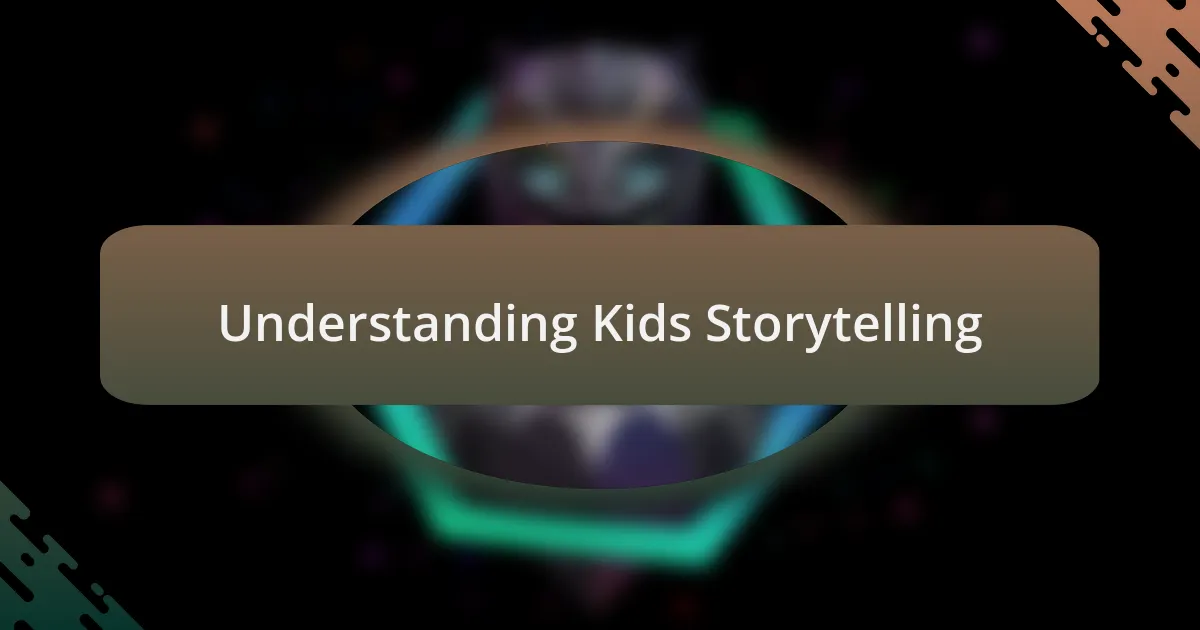
Understanding Kids Storytelling
Kids storytelling is a remarkable window into their imaginations, reflecting their emotions, dreams, and experiences. I remember when my niece, at just five years old, crafted a tale about a brave dinosaur who saved a village from a storm. It was fascinating to see how her own fears and hopes transformed into a vibrant story, making me realize how storytelling can be a powerful outlet for their feelings.
The unique narrative style of children often features unexpected twists and whimsical characters, highlighting their unfiltered creativity. Have you ever listened to a child narrate a story and wondered where they pulled that idea from? I have, and it’s incredible how their minds work, weaving together elements from their surroundings and interests. Their ability to draw connections makes their storytelling captivating and relatable.
Understanding kids’ storytelling is crucial for fostering their creativity and confidence. When I encourage my own children to share their stories, I make it a safe space for them to explore without judgment. After all, isn’t it essential for them to feel free to express themselves, even if their tales defy traditional logic?
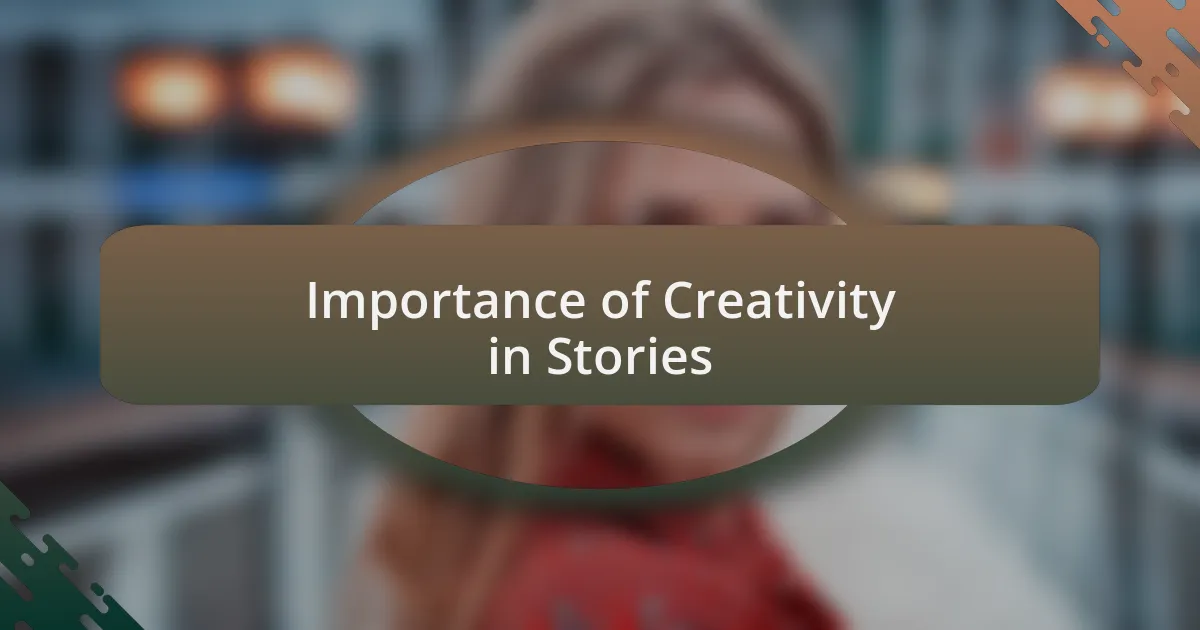
Importance of Creativity in Stories
Creativity in stories is vital because it nurtures a child’s ability to think outside the box. I recall a moment when my son created a world where candy grew on trees and animals could talk. His excitement as he detailed his made-up universe showed me that such imaginative freedom can foster problem-solving skills in real life. Isn’t it fascinating how a simple story can plant the seeds for future innovation?
Moreover, the process of crafting narratives encourages emotional intelligence. When kids invent scenarios for their characters, they naturally explore feelings and conflicts, learning empathy along the way. One time, I watched my daughter portray a character who faced a tough decision, and I realized she was working through her own feelings about a friendship issue. It made me question: don’t we all grow through the stories we hear and tell?
Furthermore, creativity in storytelling fosters resilience. Children often learn to navigate challenges that their characters face, an experience that parallels real-life situations. It reminds me of when my niece created a narrative about a lonely girl who found friends by being kind. That story not only provided entertainment but taught my niece the importance of kindness and connection—a lesson that will stay with her for years to come.
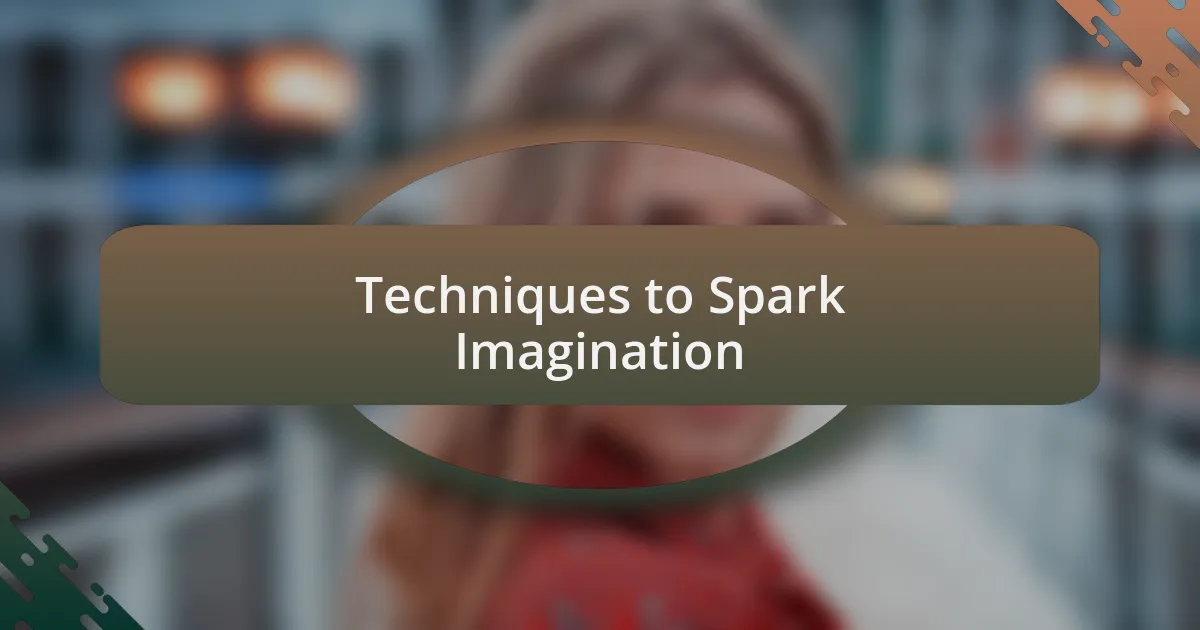
Techniques to Spark Imagination
One technique I often use to spark imagination is storytelling prompts. These prompts can be as simple as asking a child, “What if your pet could talk?” The curiosity that springs from such questions is invigorating. I remember when my daughter took this prompt and spun a tale about our dog embarking on a secret mission. The way her eyes lit up revealed just how deeply she connected with the idea, showcasing the power of a good prompt.
Another effective approach is to use everyday objects as story starters. For instance, I once handed my son a shoebox and asked him to imagine it as a treasure chest. He immediately began crafting an adventure about brave pirates and hidden jewels. By transforming mundane items into storytelling tools, we enable children to exercise their creativity in tangible ways. How often do we overlook the potential stories waiting in our own homes?
Engaging in collaborative storytelling can also unleash creativity. When I gather my children for a story-making session, I often start a tale and let them take turns adding to it. This not only encourages a flow of ideas but also fosters a sense of teamwork. I’ve seen them argue playfully over plot twists, which only fuels their excitement. Isn’t it amazing how sharing the creative process can deepen not just the story but also their bond?

Encouraging Unique Story Ideas
One effective way I encourage unique story ideas is by introducing the concept of “what if” scenarios. For instance, I shared a moment with my daughter when we discussed what would happen if the moon were made of cheese. Her eyes widened with wonder as she populated her story with characters like cheese-loving mice and adventurous astronauts. This simple twist allowed her imagination to run wild, turning an ordinary night into a delightful narrative filled with unexpected twists.
I’ve also found that incorporating elements of personal experience can lead to unique story development. I recall a camping trip where my son spotted a raccoon stealing our snacks. This sparked him to create a quirky tale about a raccoon thief with grand aspirations of fame after a heist. Using real-life moments as inspiration not only grounds the storytelling experience but also makes conversations richer and more authentic. How often do we realize that our own experiences can be the springboard for imaginative tales?
Another strategy that has proven effective is prompting children to combine seemingly unrelated elements into one story. I once asked a group of kids what they think would happen if a dragon met a librarian. The diverse ideas that emerged were nothing short of magical, from fire-breathing book critiques to reluctant friendship forming between the two. It was truly captivating to witness how mixing different concepts ignited their creativity and led to unexpected storylines. Isn’t that the beauty of storytelling? The possibilities are endless when we allow our minds to explore the unconventional.
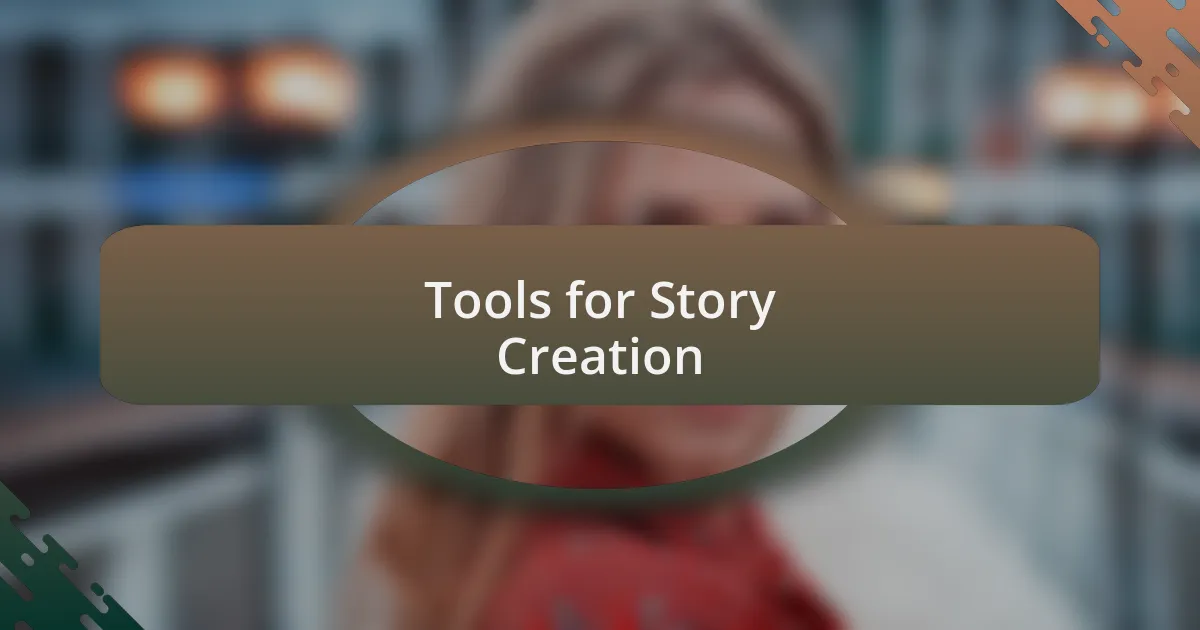
Tools for Story Creation
When it comes to tools for story creation, I find that simple craft materials can work wonders. For example, one rainy afternoon, I set up a storytelling corner with colorful paper, markers, and stickers. My children were thrilled to physically create their story worlds, drawing characters and settings. I noticed that engaging them in a tactile way not only enhanced their creativity but also gave them a sense of ownership over their stories. Have you seen how the act of making something can spark an incredible narrative?
Additionally, digital storytelling apps are fantastic tools that can bring stories to life in dynamic ways. I once downloaded a storytelling app that allowed my daughters to narrate their tales while adding music and sound effects. Watching them experiment with voice modulation and background sounds transformed their storytelling into an exciting play! It made me realize how technology can complement imagination, opening new avenues for creativity. Have you ever thought about how integrating tech can give kids a fresh perspective on their stories?
Moreover, using everyday objects as prompts can serve as great tools for stimulating creativity. For instance, I would gather random items like a feather, a spoon, and a flashlight and challenge my kids to weave a story around these objects. One time, a simple feather became a token of friendship between a shy bird and a young girl, leading to a heartwarming tale of courage. This exercise always reminds me of the fantastic ideas that can emerge from the most unexpected sources. Isn’t it fascinating how even the simplest objects can inspire profound narratives?
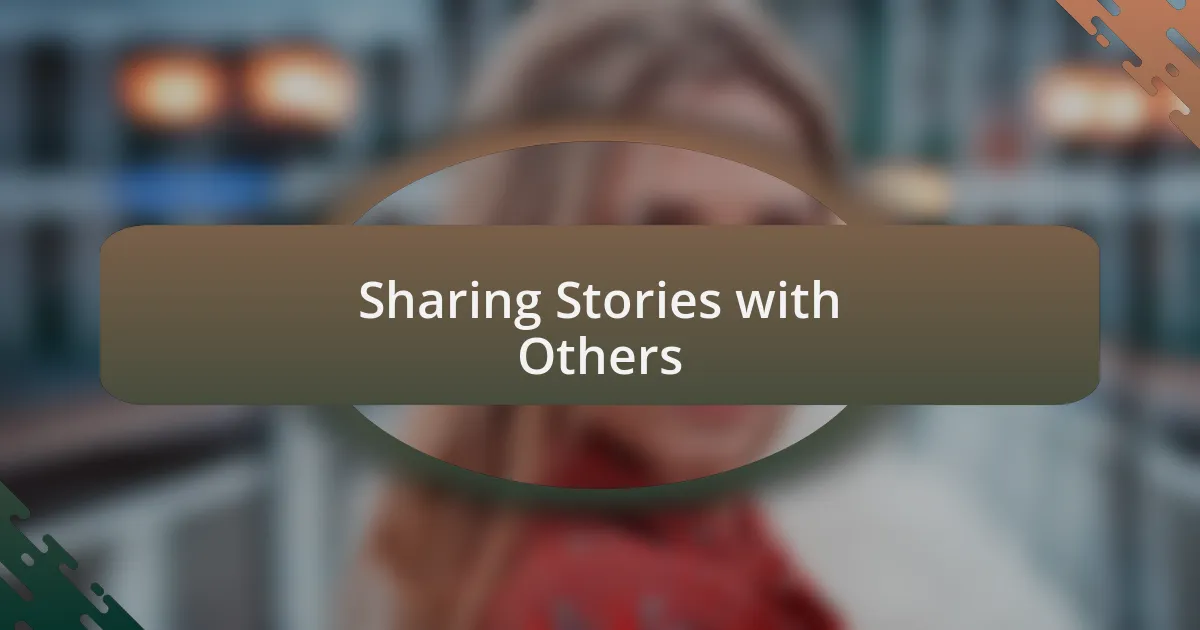
Sharing Stories with Others
Sharing stories with others can be a delightful experience that fosters connection and creativity. I remember one evening when I gathered a few friends and their kids for a storytelling night. As we each took turns sharing our tales, I noticed how the room filled with laughter and excitement, with everyone building off one another’s narratives. This communal storytelling not only sparked new ideas but also created an atmosphere of warmth and collaboration. Have you ever experienced the joy of collective storytelling?
Listening to others’ stories can open up avenues for imagination that I never even considered. For example, my son told a story about a magical tree that granted wishes to those who believed. As he spoke, I couldn’t help but think of different endings and characters for him to explore. The beauty of sharing stories lies in the possibility of collaboration, where a listener becomes a co-creator with their own unique twist. It made me realize how much we can learn from each other’s creative perspectives. Doesn’t that encourage you to listen more actively to the tales shared around you?
Moreover, I’ve found that sharing stories in varied settings—like a local library or a community park—can elevate the experience. Last summer, I attended a storytelling workshop at our neighborhood park. The captivating stories shared around the picnic tables made children’s eyes light up with imagination. That day reminded me how the setting can enrich the storytelling experience, creating lasting memories for both listeners and narrators. How do you think the environment influences the stories we share?
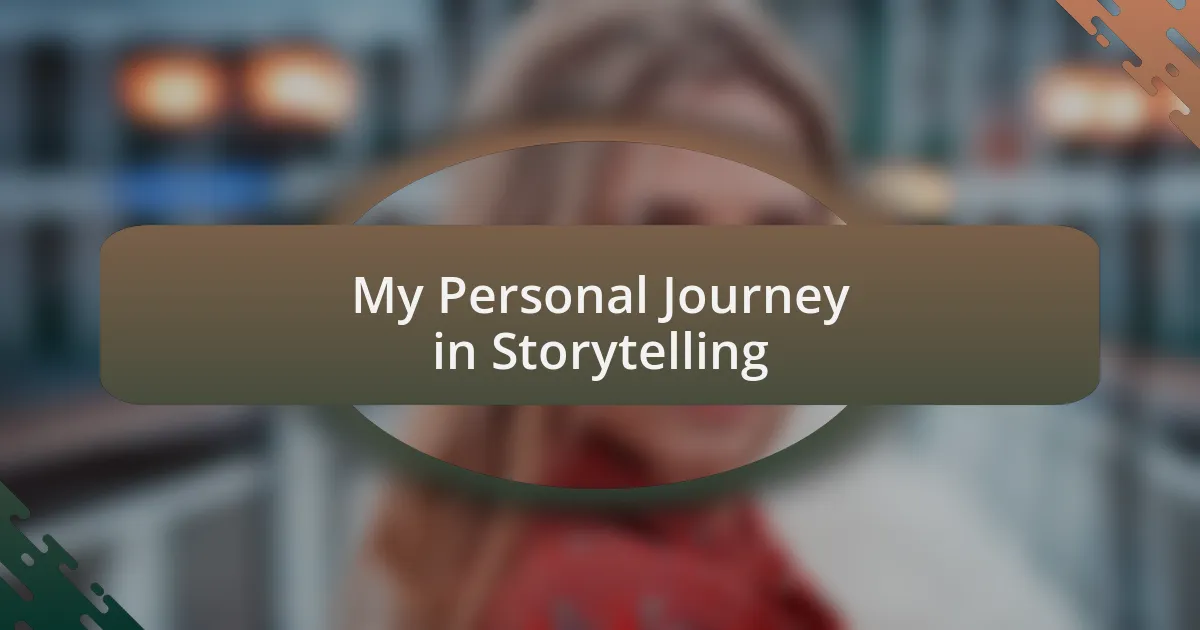
My Personal Journey in Storytelling
My journey into storytelling began in my childhood, when I would eagerly gather around the campfire with family and friends. I remember how the flickering flames seemed to dance with the magic of the stories being shared. Even back then, I felt something stir within me; the way a well-told tale could transport us to different worlds influenced my passion for storytelling in profound ways.
As I grew older, I actively sought out opportunities to share my own stories. One memorable moment was when I volunteered at a local school, weaving tales that sparked the imaginations of young listeners. Seeing their eyes widen with wonder reminded me of my own childhood experience, and I felt a deep sense of fulfillment. It was a gentle nudge from fate, showing me the power of stories to inspire and connect with others.
Recently, I’ve taken joy in experimenting with different storytelling techniques. I often find myself incorporating elements like sound effects or props to enhance the narrative. One weekend, I used a simple cardboard box to create a treasure chest for a pirate story, and the kids were completely captivated! Have you ever seen a child’s face light up with newfound excitement? Those moments not only fuel my creativity but also reinforce my belief that storytelling is a dynamic, ever-evolving art form, one that continually invites innovation and play.